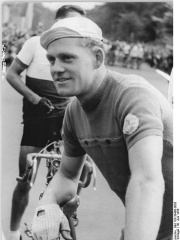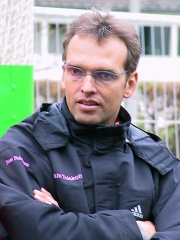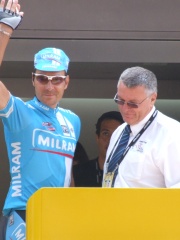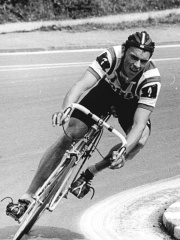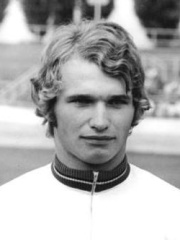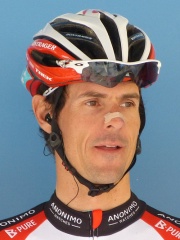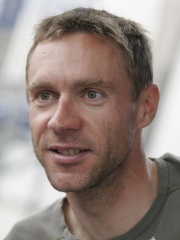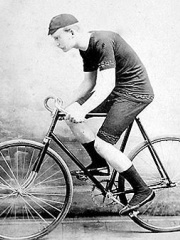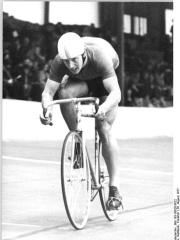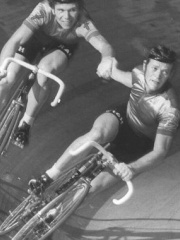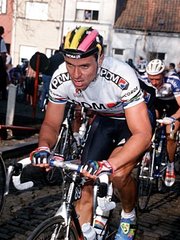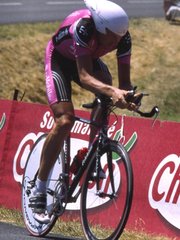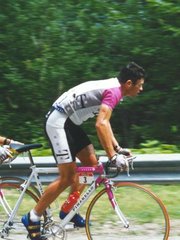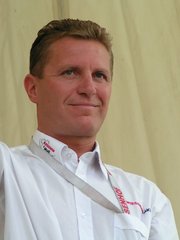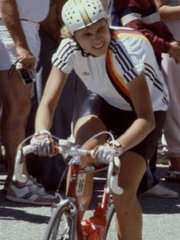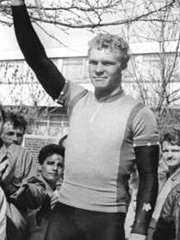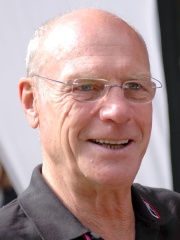
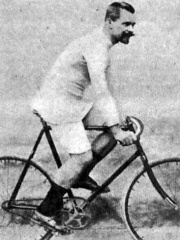

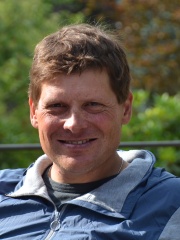
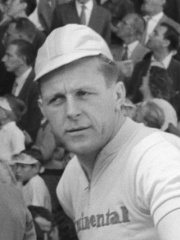
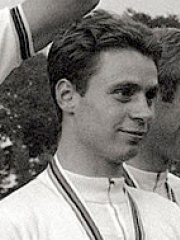
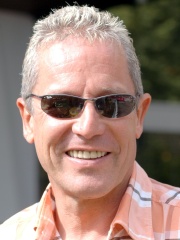
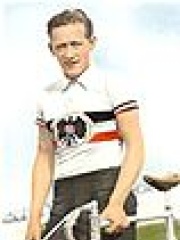
The Most Famous
CYCLISTS from Germany
Top 10
The following people are considered by Pantheon to be the top 10 most legendary German Cyclists of all time. This list of famous German Cyclists is sorted by HPI (Historical Popularity Index), a metric that aggregates information on a biography's online popularity. Visit the rankings page to view the entire list of German Cyclists.

1. Rudi Altig (1937 - 2016)
With an HPI of 61.82, Rudi Altig is the most famous German Cyclist. His biography has been translated into 23 different languages on wikipedia.
Rudi Altig (German pronunciation: [ˈʁuːdiː ˈaltɪç] ; 18 March 1937 – 11 June 2016) was a German professional track and road racing cyclist who won the 1962 Vuelta a España and the world championship in 1966. After his retirement from sports he worked as a television commentator.

2. Josef Fischer (1865 - 1953)
With an HPI of 60.43, Josef Fischer is the 2nd most famous German Cyclist. His biography has been translated into 16 different languages.
Josef Fischer (20 January 1865 – 3 March 1953) was a German road bicycle racer. He is best known for winning the first edition of Paris–Roubaix in 1896 and Bordeaux–Paris in 1900. After his retirement from active cycling, Fischer initially stayed in Paris, working as a chauffeur for noble customers. During the First World War he had to leave France and returned to Germany.

3. Rolf Wolfshohl (1938 - 2024)
With an HPI of 58.71, Rolf Wolfshohl is the 3rd most famous German Cyclist. His biography has been translated into 17 different languages.
Rolf Wolfshohl (27 December 1938 – 18 September 2024) was a German professional road bicycle racing and cyclo-cross racing cyclist. Wolfshohl is best known in cyclo-cross for winning the then unofficial cyclo-cross world championship three times, and in road racing for winning the 1965 Vuelta a España. He won the German National Road Race in 1968.

4. Jan Ullrich (b. 1973)
With an HPI of 58.45, Jan Ullrich is the 4th most famous German Cyclist. His biography has been translated into 43 different languages.
Jan Ullrich (German pronunciation: [jan ˈʊlʁɪç] ; born 2 December 1973) is a German former professional road bicycle racer. Ullrich won gold and silver medals in the 2000 Summer Olympics in Sydney. He won the 1999 Vuelta a España and the HEW Cyclassics in front of a home crowd in Hamburg in 1997. He had podium finishes in the hilly classic Clásica de San Sebastián. His victorious ride in the 1997 Tour de France led to a bicycle boom in Germany. He retired in February 2007. In 2006, Ullrich was barred from the Tour de France amid speculation of having doped. In February 2012, Ullrich was found guilty of a doping offence by the Court of Arbitration for Sport. He was retroactively banned from 22 August 2011, and all results gained since May 2005 were removed from his palmarès. In 2013 he admitted to blood doping, and in 2023 to using performance enhancing substances.
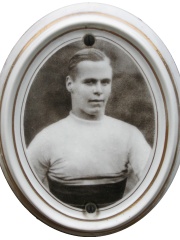
5. Albert Richter (1912 - 1940)
With an HPI of 55.86, Albert Richter is the 5th most famous German Cyclist. His biography has been translated into 16 different languages.
Albert Richter (14 October 1912 – 2 January 1940) was a German cyclist who won the world sprint championship. He was taken from a train by the Gestapo and never seen alive again.

6. Heinz Müller (1924 - 1975)
With an HPI of 55.85, Heinz Müller is the 6th most famous German Cyclist. His biography has been translated into 15 different languages.
Heinz Müller (16 September 1924 – 25 September 1975) was a German road bicycle racer who won the UCI Road Cycling World Championship in 1952. He also won the German National Road Race in 1953.

7. Willi Fuggerer (1941 - 2015)
With an HPI of 55.83, Willi Fuggerer is the 7th most famous German Cyclist. His biography has been translated into 18 different languages.
Wilhelm "Willi" Fuggerer (11 September 1941 – 2 September 2015) was a German track cyclist. He competed at the 1964 Olympics in the 2000 m tandem and 1000 m sprint and finished in third and fifth place, respectively. In the tandem semifinals he and Klaus Kobusch apparently won 2:1 against the Italian team, but were disqualified in the third race for moving out of their lane in the final sprint.

8. Dietrich Thurau (b. 1954)
With an HPI of 55.75, Dietrich Thurau is the 8th most famous German Cyclist. His biography has been translated into 21 different languages.
Dietrich "Didi" Thurau (German pronunciation: [ˈdiːtʁɪç ˈtuːʁaʊ] ; born 9 November 1954) is a retired German professional road bicycle racer. His biggest career achievements include winning the one-day classic, Liège–Bastogne–Liège, his home country's Deutschland Tour and surprising the field at the 1977 Tour de France by capturing four stages and holding the yellow jersey as leader of the general classification from the prologue for 15 days. Thurau did win the young rider classification although he lost the overall lead to eventual winner Bernard Thévenet. Thurau was German pursuit champion three times and won 29 six-day races. He is the father of former professional cyclist Björn Thurau. In 1989, he revealed he had doped throughout his career.

9. Toni Merkens (1912 - 1944)
With an HPI of 55.06, Toni Merkens is the 9th most famous German Cyclist. His biography has been translated into 18 different languages.
Nikolaus Anton "Toni" Merkens (21 June 1912 – 20 June 1944) was a racing cyclist from Germany and Olympic champion. He represented his native country at the 1936 Summer Olympics in Berlin, where he won the gold medal in the men's 1000 meter match sprint event.
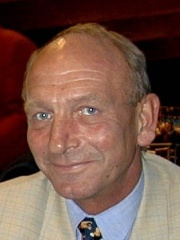
10. Jürgen Kissner (1942 - 2019)
With an HPI of 54.90, Jürgen Kissner is the 10th most famous German Cyclist. His biography has been translated into 17 different languages.
Jürgen Kissner (German: Jürgen Kißner, 18 August 1942 – 18 May 2019) was a German cyclist. He won the silver medal in the Team pursuit in the 1968 Summer Olympics.
People
Pantheon has 146 people classified as German cyclists born between 1865 and 2002. Of these 146, 132 (90.41%) of them are still alive today. The most famous living German cyclists include Jan Ullrich, Dietrich Thurau, and Gregor Braun. The most famous deceased German cyclists include Rudi Altig, Josef Fischer, and Rolf Wolfshohl. As of April 2024, 29 new German cyclists have been added to Pantheon including Uwe Raab, Grischa Niermann, and Michael Marx.
Living German Cyclists
Go to all RankingsJan Ullrich
1973 - Present
HPI: 58.45
Dietrich Thurau
1954 - Present
HPI: 55.75
Gregor Braun
1955 - Present
HPI: 53.41
Gustav-Adolf Schur
1931 - Present
HPI: 53.15
Olaf Ludwig
1960 - Present
HPI: 52.86
Günther Schumacher
1949 - Present
HPI: 52.82
Erik Zabel
1970 - Present
HPI: 52.65
Hans Lutz
1949 - Present
HPI: 52.25
Uwe Ampler
1964 - Present
HPI: 51.98
Klaus-Jürgen Grünke
1951 - Present
HPI: 51.89
Andreas Klöden
1975 - Present
HPI: 51.74
Jens Voigt
1971 - Present
HPI: 51.59
Deceased German Cyclists
Go to all RankingsRudi Altig
1937 - 2016
HPI: 61.82
Josef Fischer
1865 - 1953
HPI: 60.43
Rolf Wolfshohl
1938 - 2024
HPI: 58.71
Albert Richter
1912 - 1940
HPI: 55.86
Heinz Müller
1924 - 1975
HPI: 55.85
Willi Fuggerer
1941 - 2015
HPI: 55.83
Toni Merkens
1912 - 1944
HPI: 55.06
Jürgen Kissner
1942 - 2019
HPI: 54.90
Joseph Rosemeyer
1872 - 1919
HPI: 54.55
Lothar Thoms
1956 - 2017
HPI: 54.08
Günter Haritz
1948 - 2025
HPI: 51.76
Theodor Leupold
HPI: 49.98
Newly Added German Cyclists (2025)
Go to all RankingsUwe Raab
1962 - Present
HPI: 48.85
Grischa Niermann
1975 - Present
HPI: 48.10
Michael Marx
1960 - Present
HPI: 47.54
Rolf Aldag
1968 - Present
HPI: 46.98
Roland Günther
1962 - Present
HPI: 46.94
Uwe Messerschmidt
1962 - Present
HPI: 46.37
Roland Hennig
1967 - Present
HPI: 45.46
Bernd Gröne
1963 - Present
HPI: 45.29
Udo Bölts
1966 - Present
HPI: 44.85
Jens Heppner
1964 - Present
HPI: 44.03
Sandra Schumacher
1966 - Present
HPI: 43.89
Maik Landsmann
1967 - Present
HPI: 43.66
Overlapping Lives
Which Cyclists were alive at the same time? This visualization shows the lifespans of the 12 most globally memorable Cyclists since 1700.


